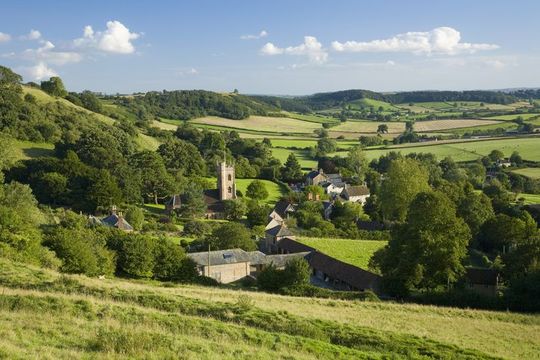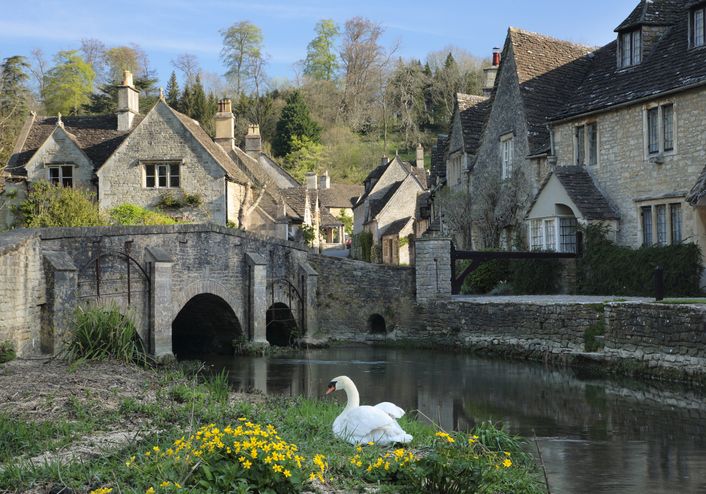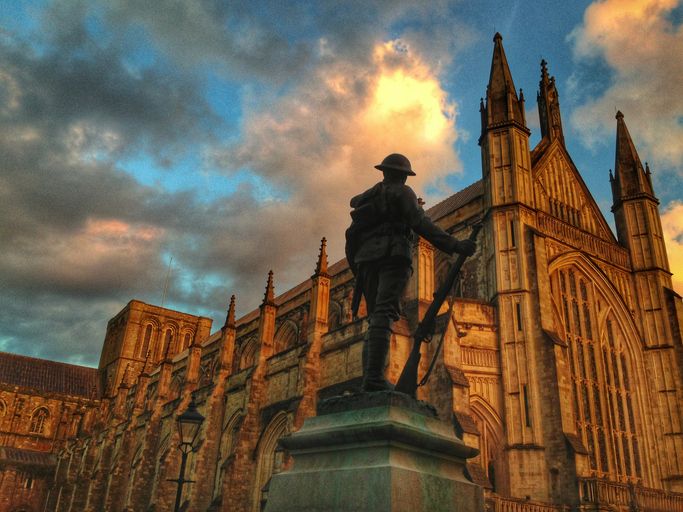
WessexGetty: Images
Dana Huntley looks to where King Alfred the Great meets Thomas Hardy.
The Roman legions and civic administrators had left, leaving the Celtic British to fend for themselves after 400 years as a Roman province subject to Roman law, custom and culture. Into the vacuum and across the land swept the Germanic tribes of Saxons, Jutes and Angles.
By the 6th century the indigenous Celts were pushed north into Scotland, west into Wales and south into Cornwall, and England was occupied by seven regional Anglo-Saxon kingdoms. In turn, Northumbria and Mercia were recognized as the strongest of these Celtic kingdoms. Through the 7th century, Christianity spread south from Northumbria and northwest from Kent.
Read more
In the late 700s, the Vikings began raiding British coastal towns and monasteries and advancing inland on the navigable rivers. By the 860s, the raids had become an invasion. The Danes had come to take the land. In 866, their army captured York, Northumbria’s major city. By this time, the southern kingdom of Wessex (the “West Saxons”) had emerged as the strongest Saxon kingdom. Its King Aethelred led the British resistance against the Vikings. But he died in 871.
Alfred’s Wessex Kingdom
Onto the throne of Wessex came Alfred. Following brief reigns by each of his three elder brothers, the youngest son of King Aethelwulf became King Alfred at the tender age of 22. Over the next years, King Alfred led Saxon defense against the Danes, emerging as the unquestioned first among Saxon kings and greatly enlarging Wessex’s territorial control. In the process, Alfred built a network of fortified towns, called burhs (“boroughs”), at distances roughly 20 miles apart from each other – close enough for its militia to come to another burh’s aid within a day.
King Alfred finally forced the Vikings to treaties that divided the country and brought a period of peace – ceding to the Vikings an eastern coastal region from East Anglia to Northumberland that became known as the Danelaw.

Wessex
For as acclaimed as Alfred was a warrior leader for his reorganization of the Anglo-Saxon army and Wessex’s defense, the King was a pious and learned man. Through the ensuing years from the mid-880s, from his court in Winchester, the largest of the burial towns, King Alfred published a comprehensive code of laws, recruited clerical scholars to establish a court school, and promoted the written use of what we call “Old English” vernacular instead of Latin. In fact, the busy monarch personally translated four books from Latin to English. Alfred also championed the Church and founded monasteries at Shaftesbury and Athelney.
King Alfred died in 899, aged 50, and was buried in the Old Minster in Winchester. Alfred is the only British king to be styled “the Great.”
Winchester: England’s First Capital
Centrally located in the network of burghal towns, Winchester was King Alfred’s de facto capital and court and site of the royal mint. An enormous bronze statue of King Alfred, sword held aloft, greets visitors to Winchester’s Broadway via what would have been its old Eastern Gate. It is certainly easier to trace the imprint of Norman kings and their successors than those of centuries known as the Dark Ages. They left a much greater written record and a stronger archaeological footprint – stone castles and cathedrals still stand.
In Winchester, however, Alfred’s legacy can still be found behind the façade of centuries. From the King’s statue near the River Itchen, trace the stonewall defenses Alfred built for the city’s protection against the Danes and explore the city on his 9th-century street plan. You will find the spot of his final resting place nearby in Hyde Abbey Gardens.
Winchester Cathedral contains the mortuary chests believed to contain the remains of 12 Anglo-Saxon kings and their wives. Learn the story at the cathedral’s new exhibition Kings and Scribes: The Birth of a Nation. The present Norman cathedral was begun in the late 11th century and is the longest of any Gothic cathedral in Europe. The foundations of the original cathedral founded in 642 are visible next door in the close. Known as the Old Minster, that was King Alfred’s royal chapel.

Winchester Cathedral
As what is often considered England’s first capital, Winchester’s historic treasures go far beyond the famous Winchester Cathedral and the ghost of Alfred the Great. After the Conquest, Winchester continued to play an important role in medieval affairs. Among the most powerful and richest Church offices in the land, the Bishop of Winchester’s palace, Wolvesey Castle near the river is maintained by English Heritage.
At the top of the High Street, Winchester Castle was built in 1067, one of the first Norman stone castles William the Conqueror erected. It was the seat of Norman kings for more than a century. Today, only the Great Hall built in the 1220s by King Henry III remains and houses the city’s history museum.
The Wessex borders of King Alfred’s day were a bit unstable to the north, east, and west. At the kingdom’s heart, however, were Hampshire, Dorset, and much of Somerset and Wiltshire. Over the following centuries, Wessex melted into English history and the notion of the old Saxon kingdom faded away. It was the Victorian novelist Thomas Hardy, from the Dorset county town of Dorchester, who fictionalized this southwestern region as “Wessex” in his novels and revived popular use of the name – a thousand years after King Alfred’s reign.
The Wessex of Thomas Hardy Country
King Alfred the Great is certainly one of the most famous names in English history, and he was voted 14th in a BBC poll of the greatest Brits. After 1,100 years off the scene and without landmarks, books, battlefields, or buildings to mark his memory, however, Alfred’s Wessex faded into the shadows of history.
As Wessex has been understood for more than a century now, it is the fictional world described by Thomas Hardy in his novels and poetry. The heart of Wessex here moves west of Winchester into the pastoral, rolling countryside of Dorset – an agrarian, rural world, with mile after mile of rolling farmland, of wheat fields and pastureland, where the way of life changed almost imperceptibly century by century. Hardy fictionalizes place names, but accurately describes in evocative detail the geography, cottage fires, village life and people of 19th century southwestern England. It has long now been known as Thomas Hardy Country.
The place to see and feel this Wessex most distinctly centers in the Dorset county town of Dorchester, renamed Casterbridge in Hardy’s novels. Just outside the market town stands Maiden Castle, among the largest Iron Age hillforts in Britain. The Celtic stronghold was conquered by the Romans and its inhabitants moved into the Roman garrison town they named Durnovaria. An ancient henge within the town, the Maumbury Rings, predates even the Celts by centuries; the Roman legionaries adapted it as an amphitheater. Dorchester had been around an eon before it became a part of King Alfred’s Wessex landscape.
Thomas Hardy (1840-1928) was born and raised just a few miles from Dorchester in a thatched cottage on the edge of Thorncombe Wood in the hamlet of Higher Bockhampton. He grew up knowing the rhythms of the agricultural year, the laborers and landlords and a life that had not changed substantively in 400 years. Nearby Dorchester, he called “the home of my heart.” After schooling as an architect in London and some years working the trade, when Hardy was successful as a writer, he returned to Dorchester in 1885 and built the house on its outskirts, Max Gate, that became home for the rest of his life.
With Casterbridge at its center, Hardy’s Wessex stretched east through Hampshire, west to Devon and north as far as Oxford. In the 1800s, though, the stability of Wessex society was shaken by the impact of the Industrial Revolution. Among its other effects was the introduction of mechanization on the farming economy. Steel-blade plows, seed drills, mowing machines and threshing machines eliminated the need for such a pool of laborers. Their world was changing.
Against this backdrop of time and place, Hardy’s characters play out the conflicts and tragedies of Return of the Native, Tess of the D’Urbervilles, Jude the Obscure and Far from the Madding Crowd. The novel that is principally set in Dorchester, however, is The Mayor of Casterbridge. Almost every scene in the story is still easily recognizable today.
A walk-through-the-novel map available at the excellent tourist information office can lead you through the story in a comfortable day’s walk, revealing the historic town’s Victorian feel and fabric in unique detail. The Corn Exchange and the King’s Arms, West Walk, the footpath into the countryside along the River Frome and St. Peters Church would all look very familiar to Hardy and his characters. Visit the Maumbury Rings, Maiden Castle and the carefully preserved remnants of a Roman townhouse for a look back to even older times.
Thomas Hardy died in 1928. His heart is buried in Stinson Churchyard in the grave of his first wife at the church he knew as a boy. Hardy is otherwise interred in Poet’s Corner at Westminster Abbey. A statue of the town’s favorite son sits at the top of Dorchester’s High Street.
As this Wessex tale unfolded, it is fair to conclude that Wessex is a brilliant travel destination. Winchester and Dorchester make the bases for a great road trip into centuries of Wessex history through a picturesque landscape and charming market towns.
In the Neighborhood
Get steeped in the countryside of Hardy’s Wessex novels on a driving excursion from Dorchester. Head north on the A352 about 20 miles through Cerne Abbas to beautiful Sherborne. Visits to Sherborne Abbey, Sherborne Old Castle and Sherborne Castle (built by Sir Walter Raleigh) are optional. Then turn south through Blackmoor Vale (the “Valley of the Big Dairies”) routing via the A357 through Sturminster Newton. Visit the working old mill near where Hardy lived for several years when he was first married. At Blandford Forum it is an easy return to Dorchester on the A354 through Puddletown, home of the Puddletown Martyrs.





Comments